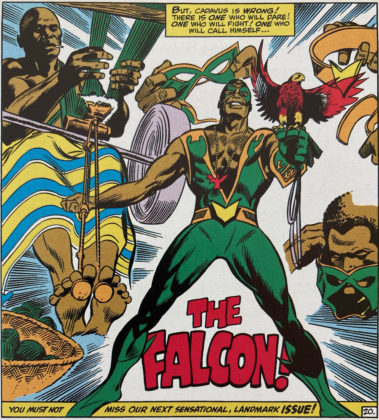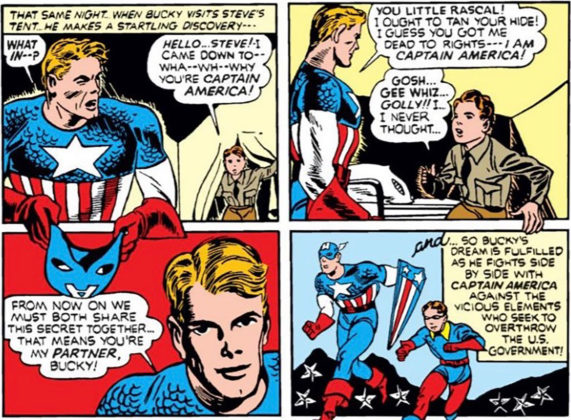
The next chapter of the Marvel Cinematic Universe begins on Friday on Disney+, promising for fans a must-see action-adventure serial.
When last we saw Sam Wilson and Bucky Barnes, at the end of Avengers: Endgame (2019), an ancient Steve Rogers – having lived a long and happy life with his true love, S.H.I.E.L.D. founder Peggy Carter, and looking remarkably like the then-future US president Joe Biden – had passed on Captain America’s shield to the Falcon.
If that last sentence means nothing to you but you’re nonetheless still interested in watching the next chapter in the Marvel Cinematic Universe (MCU), The Falcon and the Winter Soldier – which debuts on Friday on the Disney+ streaming service – then you’ll need an introduction, and you’ve come to the right place.
The Falcon and the Winter Soldier is Marvel Studios’ second television show for Disney +. It was meant to be their first, until something disrupted their plans. Not quite The Blip, so much as The Other Thing, but into that particular Covidy breach phased WandaVision, a smash-hit six-hour, nine-episode love-letter to American sitcoms which somehow managed to also be the latest blockbuster chapter in the MCU, and at the same time a heartfelt and deeply moving meditation on grief.
You wouldn’t normally expect to find yourself crying at the adventures of a wandering-accented Eastern-European witch and her British-accented robot husband, but Elizabeth Olsen and Paul Bettany are simply astonishing and – to be honest – these days most of us are probably close enough to tears at the best of times anyway.
The Falcon and the Winter Soldier stars Anthony Mackie as Sam “Falcon” Wilson and Sebastian Stan as James Buchanan “Bucky/Winter Soldier” Barnes, and both were introduced as supporting characters in the Captain America movies.
Sam and Bucky have long histories with Cap in the comics, with the Falcon dating back to 1969, when he debuted as the first mainstream African-American superhero. (The Black Panther, the first superhero of African descent in mainstream comics, debuted in 1966 and is king of the fictional African nation of Wakanda.) Bucky of course goes right back to Cap’s beginning, and first appeared in 1940, in Captain America Comics # 1.
Captain America and Bucky were created by two first-generation Jewish immigrants. Jacob Kurtzberg, born on Manhattan’s Lower East Side, was already a working artist by his early teens, churning out artwork in sweatshop conditions. In 1940, the 23-year-old – going by the pseudonym Jack Kirby – teamed up with 27-year-old writer-editor Joe (born Hymie) Simon to create a patriotic superhero for publisher Martin Goodman’s Timely Comics (which decades later would become Marvel Comics).
Steve Rogers, orphaned son of poor Irish immigrants, too sickly to enlist in the Army, volunteers for a dangerous experiment which transforms him into a super-soldier. Serving as a lowly private in Camp Lehigh, Cap’s secret identity is soon uncovered by the camp’s teen mascot, Bucky Barnes, who quickly dons a domino mask and becomes Steve’s teenaged sidekick. (When Joe Simon pitched Bucky to Goodman, he said “I think (Cap) should have a kid buddy or he’ll be talking to himself all the time”.)
Cap and Bucky’s adventures were formulaic and silly, with Steve and his teenage sidekick Bucky routinely slipping from the army base to fight zombies, werewolves and other ghouls – usually saboteurs in disguise – before returning just in time for roll call. The artwork, though, primarily Kirby’s, was astonishing, with musclebound characters bursting from the page in impossible scenes of balletic energy.
The third issue’s text story – “Captain America Foils the Traitor’s Revenge” – was the first published work of a young production assistant hired only because he was the cousin of the publisher’s wife. Stanley Lieber would eventually abandon his dreams of being a great American novelist and become better known by his pseudonym, Stan Lee.
Captain America was a smash hit, inspiring dozens of knock-off characters and regularly outselling Time Magazine, eventually starring in his own film serial (without Bucky), but post-war the character struggled with dwindling sales. Returning GIs, traumatised by war, were no longer charmed by childish stories of brightly costumed superheroes.
In 1948, Bucky was shot and seriously injured, leading to his replacement by Cap’ girlfriend, Golden Girl. Captain America limped through failed relaunches (usually fighting Communists), eventually falling dormant until 1964, when Kirby and Stan Lee successfully revived him. Lee hated teen sidekicks, and killed off Bucky, a rare comic book death which actually stuck, at least for four decades.
Awakened after years on ice, Cap was a man out of time, haunted by the death of Bucky, and a symbol of a simpler America. His struggle for relevance would become his unique selling point in the Sixties. In 1969, artist Gene Colan persuaded Stan Lee that Cap’s new partner should be African-American. Sam Wilson was a Harlem-based social worker with a Wakandan flight-suit remarkable and a remarkable telepathic link to a falcon named Redwing.
Bucky was eventually revived, in 2005, in a critically acclaimed run by writer Ed Brubaker, as the Winter Soldier, a brainwashed Soviet-era assassin.
The Marvel Cinematic Universe began three years after Bucky’s comics return, with Iron Man (2008). It’s easy now to forget what a gamble that film was for Marvel Studios, featuring an obscure character, with director Jon Favreau having to fight studio concerns about Robert Downey Jr, then still haunted by his addictions. Its post-credits scene, where Nick Fury (Samuel L Jackson) visits Tony Stark (Downey) to discuss “the Avengers initiative”, set the template for the MCU.
Kevin Feige, Marvel Studios’ chief and self-described fan-boy, imagined an interconnected cinematic universe modelled on the Marvel Comics universe created by Jack Kirby and Stan Lee, and realised that while the film rights to Spider-Man, the X-Men, and the Fantastic Four had been sold to other studios, Marvel still retained the rights to the core Avengers characters.
MCU’s next film, the now-ignored The Incredible Hulk (2008), featured a post-credits appearance by Stark. From there, the interlinked references continued, until the full-blown crossover The Avengers (2012). Captain America: The First Avenger (2011) led directly into that film, and established that James “Bucky” Barnes was Steve Rogers’ childhood protector and best friend, lost and presumed dead on a mission in early 1945.
Captain America: The Winter Soldier (2014) introduced Sam Wilson, a USAF veteran piloting an experimental flight-suit, and established that Bucky had survived WWII, and had been brainwashed to become the terrorist assassin the Winter Soldier. Since then, Bucky has been rehabilitated, and has fought alongside his childhood best friend, and Sam, his rival for Cap’s friendship.
Now, Bucky and Sam find themselves thrown together in the wake of Cap’s retirement, and they must overcome their mutual irritation to defeat Zemo (Daniel Brühl) and his terrorist Flag-Smashers, even as they come to terms with a new, US government-sanctioned Captain America.
Kevin Feige has the MCU plotted at least a decade ahead, with television shows now firmly part of the shared continuity in a way never achieved by past shows like Marvel’s Agents of S.H.I.E.L.D. Buckle up for the next chapter.
The Falcon and the Winter Soldier debuts at 8am (GMT) Friday 19 March on Disney+











